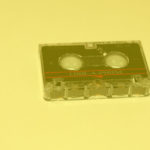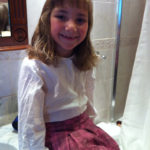At the end of June, 2010, our daughter, Sammi, was diagnosed with an inflammatory disorder called Eosinophilic Esophagitis. Her esophagus was coated in several places with the white blood cells called eosinophils, making it look something like eczema inside. These cells — these eosinophils, a word we had to practice saying, slowly — were poorly understood by even the experts on the disorder. Common knowledge at the time of her diagnosis was that they are the result of a protein intolerance.
Something Sammi was eating was making her body attack her esophagus. It could be more than one thing. It could be lots of things.
We were given two options for treating it. One was to begin treating her esophagus with what was known as a steroid slurry. The ampules of liquid steroid that were usually plugged into an asthma nebulizer would be cracked open, spilled into a dish in our kitchen and mixed with ten packets of splenda, the non-calorie sweetener. She’d then swallow this slurry twice a day, thirty minutes before eating. The steroid, mixed with the splenda, would coat the esophagus and act as a topical steroid paste, bringing down the inflammation in her esophagus. No one knew what the long-term effects of swallowing steroids would be, but they were 98% effective at resolving the symptoms of the disorder.
The other option was much more intensive, expensive, and time consuming, and it might not work. It was known as SFED — the Six Food Elimination Diet. Current thinking about eosinophilic esophagitis is that the most common triggers for the disease are the top six most common allergens: eggs, soy, nuts, fish, wheat, and dairy. Beginning by eliminating all of those foods from the diet for six weeks, and then adding each food back in, one at a time, with an endoscopy in between each one, this protocol would isolate the offending food or foods. For 80% or more of children, this worked to find the culprit or culprits, which could then be eliminated permanently from that child’s diet, leaving the child to lead an otherwise normal life.
And then we had to tell her.
It is difficult to describe what those days were like before we launched into this plan, which we decided would be a family diet whenever the four of us were together. We read the packet mailed to us by the doctors’ office, explaining all of the things that would have to be removed from her diet. It was an exhausting list. Not only could she not have any of the “six foods,” but she could not have any products which had been made on shared equipment with any of those things. We were already vegetarians, and the doctor didn’t want us to add meat into her diet if it hadn’t been there before. What was left?
We made a list. I still have it, a yellow legal pad scribbled furiously with all the things she could eat. The list was bizarre as it was lopsided, lots of fruits and vegetables, few proteins. Lots of strange grains, few familiar foods. Once we had covered both sides of a piece of paper, we sat our children down one day on the kitchen floor to try to explain to them what was coming.
They were eight and not-quite-five. Being forced to stay calm for them, to focus on the positive, was the only reason I didn’t fall to pieces. We explained that we had good news; we now knew why Sammi’s food kept coming back into her mouth. Her esophagus was sick! We drew a body on paper, showed them where the esophagus was, drew a frown on it. We talked about allergies, about our friend’s daughter with celiac disease, about feeling crummy and then feeling better. We brought out the list of allowed foods and cheered along as favorites were listed.
Blueberries! YAY!
Tortilla chips! WOO HOO!
Black beans! Avocado! Peaches! Tomatoes!
We made Sammi promise not to eat food given to her by anyone but us. We made Ronni promise to keep an eye out for her sister. We made a chart listing all the new foods we were going to try, giving everyone a vote for each one (yuck, eh, not bad, great). We hugged them tight, and they went off to play.
I wanted to cry. I didn’t. I rolled my sleeves up, pulled out my cookbooks, and got to work. This diet, in one form or another, would last a full year, and it would take everything I had. There wasn’t time to stop and weep.







[…] offered, via private message, to talk with me on the phone. I was struggling greatly with meal planning and also unable to see what life would be like for us in the long term. I was thrilled to be able to […]
[…] dairy-free, egg-free, soy-free, wheat-free, and nut-free. As part of the treatment protocol for eosinophilic esophagitis, the “six food elimination diet” was supposed to remove the worst potential allergens […]
[…] helped to know that Sammi’s slow eating was likely a symptom of eosinophilic esophagitis, or reflux, or both. It helped, but not enough. I kept feeling that nagging, nagging sensation in […]
[…] taking things out of the diet, one by one, until Sammi felt better and her esophagus ceased to have eosinophils coating its walls. In reality, the process worked in reverse. This was what her fifth year looked […]
[…] final endoscopy in a series of nine, each one marking a phase of her six-food-elimination diet for eosinophilic esophagitis. Each scope after the first one — the one that provided the diagnosis — was to test for […]
[…] with her gastroenterology team had resulted in a follow-up endoscopy that revealed the return of eosinophils. She had relapsed, and with no foods having ever been identified as specific triggers, her doctors […]
[…] odd results that were not as consistent with the gastroenterologists’ certain diagnosis of eosinophilic esophagitis, an allergic disorder of the esophagus, one of the gastroenterologists with whom we had trusted […]
[…] medication to block acid production in her stomach, diagnosis with an inflammatory disorder called eosinophilic esophagitis, and dozens of trips to gastroenterologists, my eight-year-old daughter slid under an x-ray […]
[…] When we had to tell our daughter Sammi just before her fourth birthday that she had been diagnosed with an inflammatory disorder called eosinophilic esophagitis, we did it in an age-appropriate way that, thankfully, also forced us to simplify the problem for ourselves. The new diagnosis meant a host of food restrictions that would change over time, but we focused on the first six weeks that would exclude dairy, eggs, soy, nuts, and wheat. I wrote about that conversation in a previous post: […]
[…] for most of her life. In the years prior to this surgery, she’d been mistakenly treated for eosinophilic esophagitis, an allergic/inflammatory condition of the esophagus caused by a reaction to food proteins. Every […]
[…] For more than six weeks before this photo was taken, Sammi had been asked by her team of gastroenterologists to avoid contact with — and certainly ingestion of — any foods containing dairy, wheat, soy, nuts, fish, or eggs. She was already a vegetarian, and this diet was meant as a way to pinpoint the source of her new, puzzling diagnosis: eosinophilic esophagitis. […]
[…] a few months earlier, Sammi had been diagnosed with a disease called eosinophilic esophagitis. An inflammatory condition of the esophagus — the tube that runs between the mouth and the […]
[…] and support for the conditions with which my daughter suffered. When her primary diagnosis was eosinophilic esophagitis, I asked for support for APFED, The American Partnership for Eosinophilic Disorders. After she had […]
[…] disease, called eosinophilic esophagitis, is a chronic, immune-mediated disorder, manifesting itself in patches of white blood cells and, […]
[…] of the heartbreak of this situation after the summer of my daughter Sammi’s diagnosis of eosinophilic esophagitis. To calm the raging white blood cells in her esophagus, a progressive elimination diet had been […]
[…] 2010, when my daughter Sammi was diagnosed with eosinophilic esophagitis (a misdiagnosis, it turns out, but that’s another story), I suddenly had to learn to cook […]